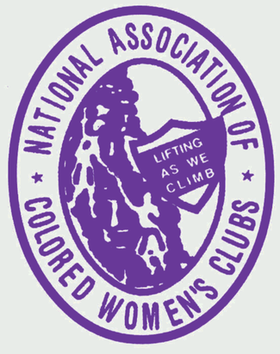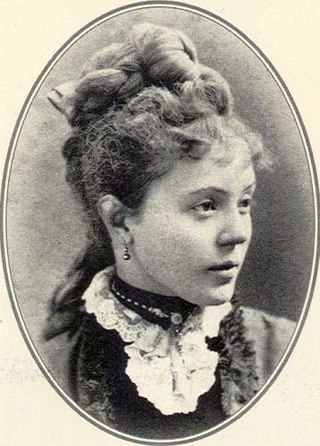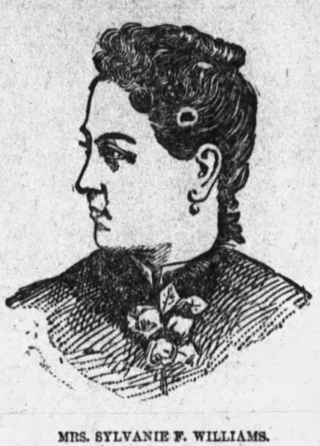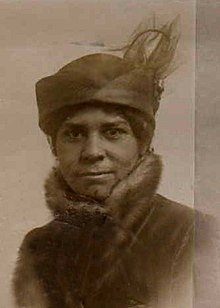
Tuskegee University is a private, historically black land-grant university in Tuskegee, Alabama. It was founded on Independence Day in 1881 by the Alabama Legislature.

The National Association of Colored Women's Clubs (NACWC) is an American organization that was formed in July 1896 at the First Annual Convention of the National Federation of Afro-American Women in Washington, D.C., United States, by a merger of the National Federation of Afro-American Women, the Woman's Era Club of Boston, and the Colored Women's League of Washington, DC, at the call of Josephine St. Pierre Ruffin. From 1896 to 1904 it was known as the National Association of Colored Women (NACW). It adopted the motto "Lifting as we climb", to demonstrate to "an ignorant and suspicious world that our aims and interests are identical with those of all good aspiring women." When incorporated in 1904, NACW became known as the National Association of Colored Women's Clubs (NACWC).

Mary Jane McLeod Bethune was an American educator, philanthropist, humanitarian, womanist, and civil rights activist. Bethune founded the National Council of Negro Women in 1935, established the organization's flagship journal Aframerican Women's Journal, and presided as president or leader for a myriad of African American women's organizations including the National Association for Colored Women and the National Youth Administration's Negro Division.

Tuskegee Airmen National Historic Site, at Moton Field in Tuskegee, Alabama, commemorates the contributions of African-American airmen in World War II. Moton Field was the site of primary flight training for the pioneering pilots known as the Tuskegee Airmen, and is now operated by the National Park Service to interpret their history and achievements. It was constructed in 1941 as a new training base. The field was named after former Tuskegee Institute principal Robert Russa Moton, who died the previous year.

Robert Russa Moton was an American educator and author. He served as an administrator at Hampton Institute. In 1915 he was named principal of Tuskegee Institute, after the death of founder Booker T. Washington, a position he held for 20 years until retirement in 1935.

Margaret Murray Washington was an American educator who was the principal of Tuskegee Normal and Industrial Institute, which later became Tuskegee University. She also led women's clubs, including the Tuskegee Woman's Club and the National Federation of Afro-American Women. She was the third wife of Booker T. Washington. She was inducted into the Alabama Women's Hall of Fame in 1972.

Nannie Helen Burroughs was an educator, orator, religious leader, civil rights activist, feminist, and businesswoman in the United States. Her speech "How the Sisters Are Hindered from Helping," at the 1900 National Baptist Convention in Virginia, instantly won her fame and recognition. In 1909, she founded the National Training School for Women and Girls in Washington, DC. Burroughs' objective was at the point of intersection between race and gender.

Sallie Wyatt Stewart was an American educator and a social services organizer for the black community in Evansville, Indiana, who is best known for her leadership in local, state, and national black women’s clubs. Stewart served as president of the Indiana Federation of Colored Women from 1921 to 1928 and succeeded Mary McLeod Bethune as president of the National Association of Colored Women from 1928 to 1933. During her term as the IFCW's president, Stewart launched "The Hoosier Woman", a monthly newsletter that served as the organization's official publication. Among her accomplishments as the NACW's president was the founding in 1930 of the National Association of Colored Girls. In addition, Stewart was a delegate in 1930 to the International Council of Women in Vienna, Austria, and fourth vice president of the National Council of Women of the United States. She also served a trustee and secretary of the Frederick Douglass Memorial and Historical Association, a member of the executive committee of the National Negro Business League, a member of the executive committee of the National Colored Merchants Association, and a teacher in the Evansville public schools for more than fifty years.

Bess Bolden Walcott (1886-1988) was an American educator, librarian, museum curator and activist who helped establish the historical significance of the Tuskegee University. Recruited by Booker T. Washington to help him coordinate his library and teach science, she remained at the institute until 1962, but continued her service into the 1970s. Throughout her fifty-four year career at Tuskegee, she organized Washington's library, taught science and English at the institute, served as founder and editor of two of the major campus publications, directed public relations, established the Red Cross chapter, curated the George Washington Carver collection and museum and assisted in Tuskegee being placed on the National Register of Historic Places.

Sarah Ella Wilson was an African American educator and clubwoman based in Massachusetts.

Adella Hunt Logan was an African-American writer, educator, administrator and suffragist. Born during the Civil War, she earned her teaching credentials at Atlanta University, an historically black college founded by the American Missionary Association. She became a teacher at the Tuskegee Institute and became an activist for education and suffrage for women of color. As part of her advocacy, she published articles in some of the most noted black periodicals of her time.
Ada Belle Dement was an American educator and clubwoman. In 1941, she became president of the National Association of Colored Women's Clubs (NACWC).

Josephine Beall Willson Bruce was a women's rights activist in the late 1890s and early 1900s. She spent a majority of her time working for the National Organization of Afro-American Women. She was a prominent socialite in Washington, D.C., throughout most of her life where she lived with her husband, United States Senator Blanche Bruce. In addition to these accomplishments, she was the first black teacher in the public school system in Cleveland, and she eventually became a highly regarded educator at Tuskegee University in Alabama.

Sylvanie Francoz Williams was an American educator and clubwoman based in New Orleans, Louisiana, USA.

Mary Jackson McCrorey was an American educator, mission worker, and leader in the Young Women's Christian Association (YWCA).

Dr. Rosa Slade Gragg was an American activist and politician. She founded the first black vocational school in Detroit, Michigan; and was the advisor to three United States presidents. She was inducted in 1987 into the Michigan Women's Hall of Fame.

Ione Elveda Wood Gibbs was an American educator, journalist, and clubwoman. She served as vice-president of the National Association of Colored Women from 1912 to 1914.
The National Federation of Colored Farmers (NFCF) was a cooperative foundation founded in 1922 by a group of African-American entrepreneurs and attorneys. Their purpose was to advance efforts to build the capacity of America’s Black farmers, by forming local chapters of buying and selling distribution cooperatives. Membership was African American farmers in the south and Midwest. This federation existed until 1949, and was registered in Illinois.

Charlotte Moton Hubbard was the U.S. deputy assistant secretary of state from 1964 to 1970, the first black woman to serve in this role.

Fannie Franklin Wall was a clubwoman, civic leader, community activist, and children's home founder.


















